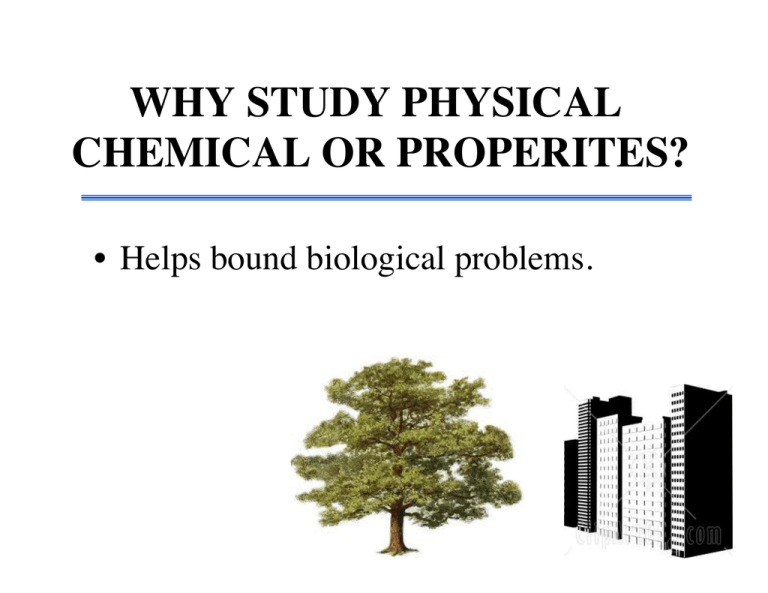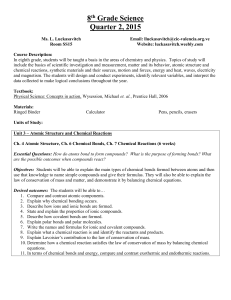Document 13888780
advertisement

WHY STUDY PHYSICAL CHEMICAL OR PROPERITES? • Helps bound biological problems. 1 WHAT IS MATTER? • Any substance that has mass and occupies space 2 WHAT IS AN ELEMENT? • Def’n - a substance with specific properties that can neither be broken down or converted to other substances by ordinary chemical reactions H He C N O Na Mg P ... 3 A FACT • Life on earth requires 25 elements, 11 are very common • H He C N O Na Mg P S Cl K Ca Fe 4 Fig. 2-02 Carbon (C): 18.5% Oxygen (O): 65.0% Hydrogen (H): 9.5% Nitrogen (N): 3.3% Calcium (Ca): 1.5% Phosphorus (P): 1.0% Potassium (K): 0.4% Sulfur (S): 0.3% Sodium (Na): 0.2% Chlorine (Cl): 0.2% Magnesium (Mg): 0.1% Trace elements: less than 0.01% Manganese (Mn) Boron (B) Chromium (Cr) Molybdenum (Mo) Cobalt (Co) Selenium (Se) Silicon (Si) Copper (Cu) Tin (Sn) Fluorine (F) Vanadium (V) Iodine (I) Zinc (Zn) Iron (Fe) WHAT IS AN ATOM? • Def’n - The smallest elemental units + - 6 WHAT IS A COMPOUND? • Def’n - A substance composed of precise proportions of two or more elements in a specific geometric pattern H20 7 WHAT IS A MOLECULE? • Def’n - The smallest unit of a compound H20 8 WHAT IS A MIXTURE? • Def’n - Two or more elements or compounds in various proportions e.g. soda pop = water, sugar, carbon dioxide, etc. Soda pop 9 WHAT IS AN ATOM? • Def’n - The smallest elemental units + - 10 A FACT • Each element has a unique number of protons in the atomic nucleus (atomic number) • H = 1 He = 2 C = 6 N = 7 Fe = 26 11 A FACT • Atoms will react with other atoms when there are vacancies on their outmost electron shells • Prediction - Helium (full shell) should be stable and Hydrogen (half-empty shell) should be reactive 12 COVALENT BONDS • Caused by closely-positioned atoms sharing electrons • The number of covalent bonds formed within a molecule depends upon number of vacancies in outer electron shell ATOMIC NUMBER H = 1 O = 8 C = 6 N = 7 13 HYDROGEN BONDS: • Weak and temporary in nature Polar 14 IONIC BONDS • Bonds between atoms of opposite charge • Electrons are transferred across atoms Atomic Number Na = 11(1) Cl = 17(7) 15 IONIC BONDS Sodium and Chlorine Atomic Number Na = 11(1) Cl = 17(7) 11 2 8 1 17 2 8 7 16 IONIC BONDS Sodium and Chlorine Atomic Number Na = 11(1) Cl = 17(7) 2 8 1 2 8 7 17 IONIC BONDS Sodium and Chlorine Ions Na+ = 11(8) Cl- = 17(8) _ + 11 2 8 17 2 8 8 18 WATER IS POLAR 19 WATER IS SPECIAL: • 3 phase presence • Heat sink • Cold sink • Cohesion • Ice floats • Good solvent 20 COHESION PROVIDES SURFACE TENSION • . . 21 COHESION PROVIDES SURFACE TENSION • http://www.youtube.com/watch?v=45yabrnryXk . . 22 CARBON IS SPECIAL • Carbon-based compounds are termed “organic” • More than 2 million organic compounds are known • Polar carbon compounds are soluble in water 23 CARBON-BASED VARIATION 24 FUNCTIONAL GROUPS: • Def’n - A specific arrangement of atoms that helps define the properties of a chemical compound e.g. amino groups. 25 SOME FUNCTIONAL GROUPS 26 A FACT • Complex organic molecules (polymers) are assembled in a simple, modular manner 27 GREAT POTENTIAL • 20 amino acids assembled into chains of 100 units gives 20 100 different possible combinations. • Number of combinations = number of different units to the exponent length of string N = us 28 DEHYDRATION SYNTHESIS HO H HO H Monomer Short Polymer H2O HO H Longer Polymer 29 IMPORTANT MACROMOLECULES • Carbohydrates • Lipids • Proteins • Polynucleotides 30 CARBOHYDRATES • Principle subtypes: – Monosaccharides e.g. glucose – Disaccharides e.g. sucrose (glucose + fructose) – Polysaccharides e.g. starch, glycogen, cellulose 31 CARBOHYDRATES • Glycogen vs. Starch Starch chemistry 32 A FACT: • Approximately 1 trillion tons of cellulose are synthesized on earth every year. 33 CHITIN • One of the most common polysaccharides on our planet 34 CHITIN • One of the most common polysaccharides on our planet 35 LIPIDS • Principle subtypes: – Fats,oils – Waxes – Phospholipids – Steroids 36 HOW SOAP WORKS • A SOAP MICELLE . 37 PROTEINS • Some functions: structural, energy storage, transport, cell movement, hormones, venom, etc. 38 GENERIC AMINO ACID 39 PROTEIN SYNTHESIS PEPTIDE WATER 40 NUCLEOTIDES 41 THE GENETIC CODE • DNA - deoxyribonucleic acid • RNA - ribonucleic acid 42 3 OTHER NUCLEOTIDES • C- AMP • ATP • Co-enzymes 43 D’ARCY THOMPSON • “ we are prisoners of the perception of our size and rarely recognize how different the world must appear to small animals … Our relative surface area is so small at our large size, we are ruled by gravitational forces acting upon our weight. But gravity is negligible to very small animals …” SCALE • Length and weight 10-8 10-5 10-1.5 10 0.3 10 1.5 Meters SCALE • Length and weight - volume = L3 10-8 10-13 10-5 10-1.5 10 0.3 10 1.5 Meters 108 Grams GRAVITY AND COHESION • Cohesion ∝ L2 10-8 10-5 Gravity ∝ L3 10-1.5 10 0.3 10 1.5 Meters 108 Grams 10-13 SOMETIMES SIZE MATTERS • e.g. gravity effects on big vs small animals True Lies BODY SIZE AND SUPPORTING STRUCTURE • Proportional skeletal mass increases with body size BODY SIZE AND SUPPORTING STRUCTURE • Proportional skeletal mass increases with body size MICROCLIMATES • Non-obvious opportunities






